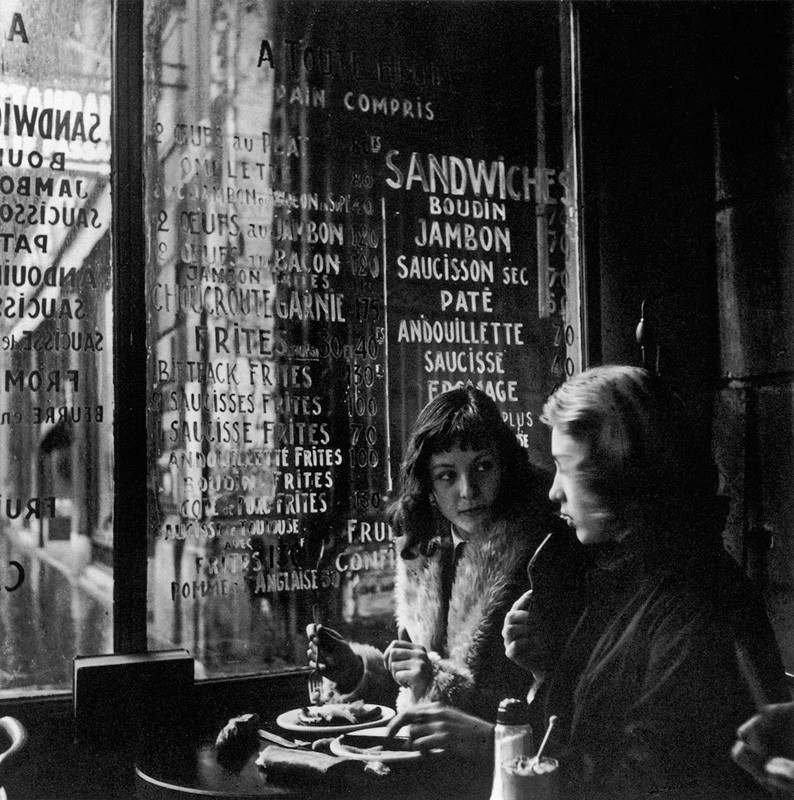Stephen Shore, Collected Works 1973-1981. Book signing and lecture at Aperture, June 7, 2017. I eat at Odeon before the lecture.
The Odeon
145 West Broadway
New York, New York 10013
212-233-0507
https://www.theodeonrestaurant.com/
Five things about Stephen Shore and The Odeon:
Stephen Shore
1. Mystery
Why did he take this photograph?
A cheap hotel room. Rust brown shag carpet. Umber brown fake leather chair. Gold brown bedspread flowers.
A bleak brown apartment building behind empty pavement. Cars parked. Empty blue sky.
A car at an intersection. Telephone poles and wires. Storefronts and signs.
Unseen. The mystery of intention. What does he see that I do not see?
2. Signs
Buying and selling: advertisements, information, injunctions, commands, questions, invitations, notices and names.
3. Composition
Form. Light and dark. Edges. Leading lines. Color. Rhythm. Stillness. Pattern. Flatness. Volume. Space compressed. Space distant. Vertical and horizontal. Beauty and ugliness.
4. Story
Paul Graham: “There are a thousand novels in these images.
Perception and wonder.” It is mute. It is multitude. Beauty and coarseness. I feel stillness.
5. Still Life
Dirty dishes on a table: two smoked cigarettes, three pickles, two crumpled napkins on dirty plates, 1/2 a cup of tea with a lemon slice floating, dirty utensils, 1/2 and 1/2 plastic creme cups….
The Odeon
A neon-lit promise of excitement on Tribeca’s then dark streets, the Odeon was the restaurant that defined New York’s 80s: a retro haven for the likes of Warhol and Basquiat, De Niro and Belushi, with a cocaine-fueled scene captured in Bright Lights, Big City.
Frank Digiacomo
1. We are at Area
It is 1983. Keith Haring painted the walls. Club kids are in the swimming pool naked. Unisex bathrooms. Art films running on monitors. Artists, writers, Euro-trash, Wall Street masters of the universe, fashionistas, and beautiful people. Look! There is Boy George, David Byrne, Jean Michel Basquiat, Sting, and Ann Magnuson! We dance to Kraftwerk, Berlin, Eurythmics, Tom Tom Club, Flock of Seagulls, Human League, New Order and Soft Cell. It is 4:00 a.m. We need food, we need drink and it is too late to go to bed.
We walk from Area. Tribeca is dark, deserted, decayed and dangerous. Abandoned iron buildings and empty cobblestone streets. In the shadows are fear and excitement. But we are high from the energy of the club, we are high from the music and the dance and the life, and we are high from the drugs. We are at Odeon. The end and the beginning of the night.
2. The Odeon Sign
Lena Dunham: And because I’m an officially deranged daughter of TriBeCa, the Odeon neon sign now lives on my ass for life.
The Odeon sign has progressed (or regressed) from the front cover of McInerney’s “Bright Lights, Big City” in 1984 to Lena Dunham’s ass in 2017. How many restaurants have been culturally relevant (or even in business) for that long? Imagine the distance from Jay McInerney to Lena Dunham.
3. Bauhaus
Primary colors, thick straight lines across white space. The trilogy of circle, triangle and square. Man reading a paper and drinking a coffee in black and red.
Old wood long bar with the huge mirror overhead made for conversation. The neon clock in the corner glows green and pink soft. It marks the time and is timeless. 1980 to 2017.
4. Odeon. Cafeteria. Cafe. Brasserie.
The soft globe lights make everyone beautiful. The old polished wood, bistro chairs and tables, the ceiling fans, white tablecloths and burgundy banquettes are familiar. The Art deco accents, the red awnings and red-orange neon lights. It is an expression of the Bistro Archetype.
Vanity Fair says:
“They hit the Zeitgeist with the architecture,” says Joe Helman, an art dealer who was instrumental in making the Odeon a popular place to fête an artist in the 80s. “The Odeon was kind of retro, without being kitsch. It was one of the places that really defined the moment.” Self-conscious without being pretentious—which couldn’t always be said of its customers—the Odeon’s design, its flattering lighting and aesthetically pleasing staff appealed to a younger, more cosmopolitan generation’s love of the cinematic, and its preoccupation with looking good.
5. Food
The best French onion soup and chocolate ice cream in town. The food is consistent and sometimes inspired. Favorites on the menu: brook trout, roasted half chicken, Faroe Islands salmon, and the steak frites. From the brasserie, the tuna burger, moules frites, and croque monsieur. New York and Paris standards.
It’s easy to see why The Odeon has been a part of the fabric of TriBeCa life for so long. Like watching a re-run of Seinfeld, it is reassuringly familiar, classically New York and, even when you know what’s coming next, still eminently satisfying.
New York Times
Resources
A great history of Odeon written on its 25th year anniversary by Vanity Fair
http://www.vanityfair.com/style/2005/11/odeon200511
https://www.nytimes.com/2016/12/27/dining/the-odeon-review.html
Stephen Shore
https://newrepublic.com/article/115243/stephen-shore-photography-american-surfaces-uncommon-places
http://aperture.org/shop/stephen-shore-selected-works-1973-1981/
Area
The definitive book on Area:
Eric Goode, Area: 1983-1987 (Harry N. Abrams 2013)
http://dangerousminds.net/comments/the_art_of_parties_new_yorks_legendary_80s_nightclub_area
